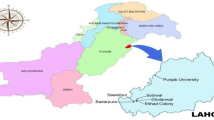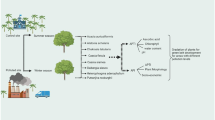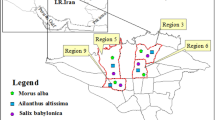Abstract
The green space of parks with its vegetation population of trees and shrubs plays a key role in air purification and the absorption of air pollutions, thereby contributing to the alleviation of environmental pollutions. The present factorial experiment was carried out in urban parks with 18 treatments. The leaf samples of 18 ornamental species were collected in two sites [(1) the margin and (2) the downtown] of Rasht city in north of Iran. Then, they were subjected to the measurement of leaf relative water content, total chlorophyll content, leaf extract pH, and ascorbic acid content to evaluate their air pollution tolerance index (APTI). The tolerance of the species was assessed by two methods: the comparison of their APTI with the average APTI of all species and the use of a constant APTI as a standard. The results showed that the species differed in their tolerance in different sites. Among the studied 18 species, Yucca filamentosa and Berberis thunbergii were identified as air pollution-tolerant species, so they are recommended for the use in parks. Yucca had an APTI of 78.24 and Berberis had an APTI of 67.56. The lowest APTI was obtained from Fraxinus excesio and Ligustrum texanum.






Similar content being viewed by others
Change history
16 March 2021
A Correction to this paper has been published: https://doi.org/10.1007/s10668-020-01098-x
References
Abed Esfahan, A., Amini, H., & Araj Shirvani, M. (2011). Assessment of air pollution tolerance index for some plant species plants in green belt of Eastern Isfahan. In Proceeding of 6th national conference on new ideas in agriculture (pp. 1–4).
Agarwal, R. M., & Tiwari, H. S. (1997). Growth of rice under different potassium doses and low external water potentials. Journal of Potassium Research, 13(1), 58–62.
Amini, H., Araj Shirvani, A., Sadeghian, M., & Banitaba, A. (2009). Assessment of air pollution tolerance index using some plant species included for the expansion of green belt of Isfahan City. In Proceedings of 4th regional conference on new ideas in agriculture (pp. 175–179).
Assadi, A., Ghasemi Pirbalouti, A., Malekpoor, F., Teimori, N., & Assadi, L. (2011). Impact of air pollution on physiological and morphological characteristics of Eucalyptus camaldulensis Den. Journal of Food, Agriculture and Environment, 9(2), 676–679.
Chaudhary, C. S., & Rao, D. N. (1977). A study of some factors in plants controlling their susceptibility to S02 pollution. Proceedings of Indian National Science Academy, 43, 236–241.
Conklin, P. L. (2001). Recent advances in the role and biosynthesis of ascorbic acid in plants. Plant, Cell and Environment, 24, 383–394. https://doi.org/10.1046/j.1365-3040.2001.00686.x.
Dedio, W. (1975). Water relations in wheat leaves as screening test for drought resistance. Canadian Journal of Plant Science, 55, 369–378. https://doi.org/10.4141/cjps75-059.
Du, M. H., Zhang, N. Q., Li, Y. Y., Hu, L. Q., & Qiao, P. (2007). Effect of atmosphere pollution on chlorophyll content in greening plant leaves. Environmental Monitoring China, 23(2), 86–88.
Enete, I. C., Chukwudeluzu, V. U., & Okolie, A. (2013). Evaluation of air pollution tolerance index of plants and ornamental shrubs in Enugu city: Implications for urban heat island effect. Journal of Experimental Research, 1(1), 1–9. https://doi.org/10.9790/2402-0122225.
Escobedo, F. J., Wagner, J. E., & Nowak, D. J. (2008). Analyzing the cost effectiveness of Santiago, Chile’s policy of using urban forest to improve air quality. Journal of Environmental Management, 86, 148–157. https://doi.org/10.1016/j.jenvman.2006.11.029.
Flowers, M. D., Fiscus, E. L., & Burkey, K. O. (2007). Photosynthesis, chlorophyll fluorescence, and yield of snap bean (Phaseolus vulgaris L.) genotypes differing in sensitivity to ozone. Environmental and Experimental Botany, 61, 190–198.
Ghosh, P. K., De, T. K., & Maiti, T. K. (2014). Ascorbic acid production in root, nodule and Enterobacter spp. (Gammaproteobacteria) isolated from root nodule of the legume Abrus precatorius L. Biocatalysis and Agricultural Biotechnology, 4(2), 127–134. https://doi.org/10.1016/j.bcab.2014.11.006.
Grantz, D. A., Garner, J. H. B., & Johnson, D. W. (2003). Ecological effects of particulate matter. Environment International, 29, 213–239. https://doi.org/10.1016/s0160-4120(02)00181-2.
Han, Y., Wang, Q. Y., & Han, G. X. (1995). The analysis about SOD activities in leaves of plants and resistance classification of them. Journal of Liaoning University (Natural Sciences Edition), 22(2), 71–74.
Helrich, K. C. (1990). Official methods of analysis of the AOAC. Volume 2 (No. Ed. 15). Association of Official Analytical Chemists Inc., p. 1298.
Hoque, M. A., Banu, M. N. A., & Okuma, E. (2007). Exogenous proline and glycinebetaine increase NaCl-induced ascorbate–glutathione cycle enzyme activities, and proline improves salt tolerance more than glycinebetaine in tobacco Bright Yellow-2 suspension-cultured cells. Journal of Plant Physiology, 164, 1457–1468. https://doi.org/10.1016/j.jplph.2006.10.004.
Huang, X. D., El-Alawi, Y., Penrose, D. M., Glick, B. R., & Greenberg, B. M. (2004). A multi-process phytoremediation system for removal of polycyclic aromatic hydrocarbons from contaminated soil. Environmental Pollution, 130, 465–476. https://doi.org/10.1016/j.envpol.2003.12.018.
Hui Yun, M. (2007). Effect of ozone on CO2 assimilation and PSII function in plants with contrasting pollutant sensitivities. Ph.D. Thesis, University of Virginia.
Jiang, G. M., Han, X. G., & Lin, G. H. (1997). Response of plant growth to elevated CO2: A review on the chief methods and basic conclusions based on experiments countries in past decade. Acta Phytoecologica Sinica, 21(6), 489–502.
Joshi, P. C., & Swami, A. (2009). Air pollution induced changes in the photosynthetic pigments of selected plant species. Journal of Environmental Biology, 30(2), 295–298.
Jyothi, J. S., & Jaya, D. S. (2010). Evaluation of air pollution tolerance index of selected plant species along roadsides in Thiruvananthapuram, Kerala. Journal of Environmental Biology, 31, 379–386.
Kammerbauer, J., & Dick, T. (2000). Monitoring of urban traffic emissions using some physiological indicators in Ricinus communis L. plants. Archives of Environmental Contamination and Toxicology, 39(2), 161–166. https://doi.org/10.1007/s002440010092.
Kermani, F., Ahmadi Dastjerdi, M. R., Piri, F., & Noori Gohar, A. (2017). Evaluation and comparison of the concentration of lead in the plant species of Yucca and Genisteae in the areas under the effect of urban traffic. In 4th international conference on environmental management and planning. Tehran, Iran.
Kiran Kumar, S. J., Raj, K. S., & Deepalakshmi, A. P. (2016). Plants as bio-indicators and bio-monitors of urban air pollution. International Journal of Scientific & Engineering Research, 7(2), 449–455.
Klumpp, G., Furlan, C. M., & Domingos, M. (2000). Response of stress indicators and growth parameters of Tibouchina pulchra Cogn. exposed to air and soil pollution near the industrial complex of Cubatão, Brazil. Science of the Total Environment, 246, 79–91. https://doi.org/10.1016/s0048-9697(99)00453-2.
Kohan, A., Haghighi, M., Ehtemam, M., & Mirghaffari, N. (2018). The effect of gasoline exhaust pollution on some anatomical, physiological and morphological characteristics of spinach. Journal of Environmental Studies, 43(4), 683–697.
Lacher, W. (1995). Physiological plant ecology (p. 513). Berlin: Springer. https://doi.org/10.1007/978-3-642-87851-0.
Lauenorth, W. K., & Dodd, J. L. (1981). Chlorophyll reduction in western wheat grass (Agropyron smithiii Rydb.) exposed to sulphur dioxide. Water, Air, and Soil Pollution, 15, 309–315. https://doi.org/10.1007/bf00285044.
Liao, L. J., Cao, H. L., Wu, L. F., & Chen, Y. Z. (2011). Effects of auto-exhaust pollution on four native ornamental trees: Stomatal and photosynthetic responses. Journal of Tropical and Subtropical Botany, 19(5), 446–452. https://doi.org/10.3969/j.issn.1005-3395.2011.05.009.
Lichtenthaler, H. K. (1987). Chlorophylls and carotenoids: Pigments of photosynthetic biomembranes. Methods in Enzymology, 148, 350–382. https://doi.org/10.1016/0076-6879(87)48036-1.
Liu, R. K., Shen, Y. W., & Liu, X. J. (1983). A study on physiological responses of plant to SO2. Plant Physiology Communications, 4, 25–28.
Liu, Y. J., & Ding, H. (2008a). Variation in air pollution tolerance index of plants near a steel factory: Implications for landscape-plant species selection for industrial areas. WSEAS Transactions on Environment and Development, 1(4), 24–32.
Liu, Y. J., & Ding, H. (2008b). Sulfur absorption ability by plant leaves and its use in landscape. Urban Environment and Urban Ecology, 6(2), 10–12.
Mickler, R. A., McNulty, S. G., & Birdsey, R. A. (2003). Responses of forests in the eastern US to air pollution and climate change. Developments in Environmental Science, 3, 345–358. https://doi.org/10.1016/s1474-8177(03)03019-5.
Mohammadi, M. (2014). What dangers threaten Guilan air? ISNA News Agency.
Muneer, S., Kim, T. H., Choi, B. C., Lee, B. S., & Lee, J. H. (2014). Effect of CO, NO2 and SO2 on ROS production, photosynthesis and ascorbate-glutathione pathway to induce Fragaria × annasa as a hyperaccumulator. Redox Biology, 2, 91–98. https://doi.org/10.1016/j.freeradbiomed.2014.02.021.
Ogunkunle, C. O., Suleiman, L. B., Oyedeji, S., Awotoye, O. O., & Fatoba, P. O. (2015). Assessing the air pollution tolerance index and anticipated performance index of some tree species for biomonitoring environmental health. Agroforestry Systems, 89(3), 447–454. https://doi.org/10.1007/s10457-014-9781-7.
Oka, E., Tagami, Y., Oohashi, T., & Kondo, N. (2003). A physiological and morphological study on the injury caused by exposure to the air pollutant, peroxyacetyl nitrate (PAN), Based on the quantitative assessment of the injury. Journal of Plant Research, 117(1), 27–36. https://doi.org/10.1007/s10265-003-0127-1.
Olumi, H., Rezanejad, F., & Keramat, B. (2016). Comparative study of biochemical parameters of Pinus nigra and P. elderica cultivated in the area around Sarcheshmeh copper complex and Kantuyeh. Environmental Plant Physiology Journal, 10(40), 1–12.
Onwurah, I., Ogugua, V., Onyike, N., Ochonogor, A., & Otitoju, O. (2007). Crude oil spills in the environment, effects and some innovative clean-up biotechnologies. International Journal of Environmental Research, 1(4), 307–320. https://doi.org/10.1046/j.1365-3040.2001.00671.x.
Pasqualini, S., Batini, P., Ederli, L., Porceddu, A., Piccioni, C. D. E., Marchis, F., et al. (2001). Effects of short-term ozone fumigation on tobacco plants: Response of the scavenging system and expression of the glutathione reductase. Plant, Cell and Environment, 24, 245–252. https://doi.org/10.1046/j.1365-3040.2001.00671.x.
Patidar, S., Bafna, A., Batham, A. R., & Panwar, K. (2016). Impact of urban air pollution on photosynthetic pigment and proline content of plants growing along the AB road Indore city, India. International Journal of Current Microbiology and Applied Sciences, 5(3), 107–113. https://doi.org/10.20546/ijcmas.2016.503.015.
Prajapati, S. K., & Tripathi, B. D. (2008). Anticipated Performance Index of some tree species considered for green belt development in and around an urban area: A case study of Varanasi city, India. Journal of Environmental Management, 88, 1343–1349.
Rai, R., Rajput, M., Agrawal, M., & Agrawal, S. B. (2011). Gaseous air pollutants: A review on current and future trends of emission and impact on agriculture. Journal of Scientific Research, 55, 77–102.
Ramakrishnaiah, H., & Somashekar, R. K. (2003). Higher plants as biomonitors of automobile pollution. Ecology, Environment and Conservation, 9(3), 337–343.
Ramezani, B., & Mohammadi, M. (2011). The recognition of urban heat island in Rasht city. Journal of Physical Geography, 3(10), 111–125.
Rao, D. N. (1979). Plant leaf as pollution monitoring device. Fertilizer News, 1, 25–28.
Rashidi, F., Jalili, A., & Abbas Azimi, R. (2017). Response of round-leaf ash (Fraxinus rotundifolia Mill.) leaves to urban pollutant gases. Iranian Journal of Forest and Poplar Research, 25(1), 13–22.
Ritchie, S. W. T., Nguyen, H. T., & Holaday, A. S. (1990). Leaf water content and gas-exchange parameters of two wheat genotypes differing in drought resistance. Crop Science, 30, 105–111. https://doi.org/10.2135/cropsci1990.0011183x003000010025x.
Scholz, F., & Reck, S. (1977). Effects of acids on forest trees as measured by titration in vitro, inheritance of buffering capacity in Picea abies. Water, Air, and Soil Pollution, 8, 41–45. https://doi.org/10.1007/bf00156723.
Seyyednejad, S. M., Majdian, K., Koochak, H., & Niknejad, M. (2011a). Air pollution tolerance indices of some plants around industrial zone in south of Iran. Asian Journal of Biological Sciences, 4, 300–305.
Seyyednejad, S. M., Niknejad, M., & Koochak, H. (2011b). A review of some different effects of air pollution on plants. Research Journal of Environmental Sciences, 5(4), 302–309. https://doi.org/10.3923/rjes.2011.302.309.
Shafiq, M., Zafar Iqbal, M., Athar, M., & Qayyum, M. (2009). Effect of auto exhaust emission on the phenology of Cassia siamea and Peltophprum pterocarpum growing in different areas of Karachi. African Journal of Biotechnology, 8(11), 2469–2475.
Singh, S. K., & Rao, D. N. (1983). Evaluation of the plants for their tolerance to air pollution. In Proceedings of symposium on air pollution control”, Indian Association for Air Pollution Control. New Delhi (pp. 218–224).
Singh, S. K., Rao, D. N., Agrawal, M., Pandey, J., & Narayan, D. (1991). Air pollution tolerance index of plants. Journal of Environmental Management, 32, 45–55. https://doi.org/10.1016/s0301-4797(05)80080-5.
Singh, S. N., & Verma, A. (2007). Phytoremediation of air pollutants: A review. Environmental Bioremediation Technology. https://doi.org/10.1007/978-3-540-34793-4_13.
Su, X., Hu, D. Q., Lin, Z. F., Lin, G. Z., Kong, G. H., & Peng, C. L. (2002). Effect of air pollution on the chlorophyll fluorescence characters of two afforestation plants in Guangzhou. Acta Phytoecological Sinica, 26(5), 599–604.
Swami, A., Bhatt, D., & Joshi, P. C. (2004). Effect of automobile pollution on Sal (Shorea robusta) and Rohini (Mallotus phillipinensis) at Asarori, Dehradun. Himalayan Journal of Environment and Zoology, 18(1), 57–61.
Swami, A., & Chauhan, D. (2015). Impact of air pollution induced by automobile exhaust pollution on air pollution tolerance index (APTI) on few species of plants. International Journal of Scientific Research, 4, 342–343.
Türk, R., & Wirth, V. (1975). The pH dependence of SO2 damage to lichens. Oecologia, 19, 285–291. https://doi.org/10.1007/bf00348104.
Uka, U. N., & Chukwuka, K. S. (2014). Effects of air pollution on physiological and morphological characteristics of Manihot Esculenta Crantz. Pollution Research, 33(4), 13–18.
Varshney, S. R. K., & Varshney, C. K. (1984). Effects of S0 on ascorbic acid in crop plants. Environmental Pollution (A), 35, 285–290. https://doi.org/10.1016/0143-1471(84)90074-6.
Velikova, V., Yordanov, I., & Edreva, A. (2000). Oxidative stress and some antioxidant systems in acid rain-treated bean plants: Protective role of exogenous polyamines. Plant Science, 151(1), 59–66.
Verweij, W., Spelt, C., Di Sansebastiano, G. P., Joop, V., Lara, R., Francesco, F., et al. (2008). An H+ P-ATPase on the tonoplast determines vacuolar pH and flower colour. Nature Cell Biology, 10(12), 1456–1462. https://doi.org/10.1038/ncb1805.
Wu, S. J. (2006). Correlation of chlorophyll in leaves and SO2 in air. Journal of Quanzhou Normal University (Natural Science), 24(4), 110–113.
Yan-Ju, L., & Hui, D. (2008). Variation in air pollution tolerance index of plants near steel factory. Implication for landscape-plant species selection for industrial areas. Environment and Development, 1(4), 24–30.
Zhang, P. Q., Liu, Y.-J., Chen, X., Yang, Z., Zhu, M-h, & Li, Y. P. (2016). Pollution resistance assessment of existing landscape plants on Beijing streets based on air pollution tolerance index method. Ecotoxicology and Environmental Safety, 132, 212–223. https://doi.org/10.1016/j.ecoenv.2016.06.003.
Zhen, S. Y. (2000). The evolution of the effects of SO2 pollution on vegetation. Ecology Sciences, 19(1), 59–64.
Zhou, Z. L. (1996). Screening, propagating and demonstrating of pollutant-tolerant trees in Beijing. Garden Scientific Technological Information, 9, 1–19.
Zou, X. D. (2007). Study on the air effects of urban green space system. Shanghai Jiao Tong University.
Author information
Authors and Affiliations
Corresponding author
Ethics declarations
Conflict of interest
All authors have read and approved the final manuscript. The authors have no conflict of interest.
Research involving human participants and/or animals
For this type of study, formal consent is not required.
Informed consent
Informed consent was obtained from all individual participants included in the study.
Ethics approval
This article does not contain any studies with human participants or animals performed by any of the authors.
Additional information
Publisher's Note
Springer Nature remains neutral with regard to jurisdictional claims in published maps and institutional affiliations.
Rights and permissions
About this article
Cite this article
Ghafari, S., Kaviani, B., Sedaghathoor, S. et al. Assessment of air pollution tolerance index (APTI) for some ornamental woody species in green space of humid temperate region (Rasht, Iran). Environ Dev Sustain 23, 1579–1600 (2021). https://doi.org/10.1007/s10668-020-00640-1
Received:
Accepted:
Published:
Issue Date:
DOI: https://doi.org/10.1007/s10668-020-00640-1




